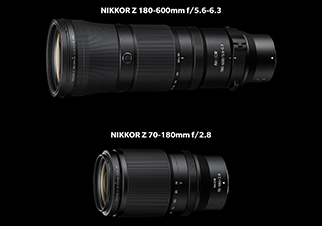
Category Archives: news


Nikon Introduces Two Telephoto Zoom Lenses for Mirrorless Cameras
Nikon has recently expanded its mirrorless lens line-up by introducing two telephoto zoom lenses. This move marks a shift towards catering to full-frame camera users and offers versatile reach in compact packages at an affordable price. The two lenses, NIKKOR Z 180-600mm f/5.6-6.3 and Z 70-180mm f/2.8, bring exciting features to the table.
Starting with the NIKKOR Z 180-600mm f/5.6-6.3, it serves as Nikon’s mirrorless successor to the popular F-mount AF-S 200-500mm f/5.6 lens. The lens provides extended reach on both ends of the focal length range, making it ideal for capturing wildlife, sports, and aerial subjects. It offers 5.5 stops of vibration reduction, compensating for any aperture loss when zooming in. Additionally, it allows for close focusing, enabling photographers to capture subjects like flowers and insects. The lens boasts a compact design, weighing 4.3 pounds, and features customizable Fn buttons for convenient handheld shooting. It incorporates an extensive optical design, including six ED glass elements to minimize chromatic aberration. With weather sealing and internal zoom, it remains resistant to dust and moisture. The lens also supports video applications, offering smooth focus transitions and fast autofocus.
On the other hand, the NIKKOR Z 70-180mm f/2.8 lens completes Nikon’s trio of affordable, fast, and compact f/2.8 zoom lenses, alongside the 17-28mm f/2.8 and 28-75mm f/2.8 lenses. It covers a versatile zoom range, almost matching the popular 70-200mm lens used in various photography genres. With a smaller and lighter design, weighing 1.75 pounds, it provides enhanced portability for extended shooting sessions. The lens is equipped with advanced elements, including ED and aspherical elements, to ensure high image quality and minimize aberrations. Its fast f/2.8 aperture excels in low-light conditions and produces pleasing bokeh and shallow depth of field. The lens allows for close focusing, making it suitable for capturing details in wedding photography. It features suppressed focus breathing, silent autofocus, and compatibility with tele converters for extended reach and macro capabilities.
Photographers and videographers will find these lenses appealing due to their versatility, affordability, and excellent performance. The NIKKOR Z 180-600mm f/5.6-6.3 lens is priced at ₹1,69,995 and will be available by August 2023, while the NIKKOR Z 70-180mm f/2.8 lens costs ₹1,19,995 and will be available by mid-July 2023.

Nikon Enhances Nikon Z9 Camera with Firmware Version 4.00, Introducing Auto Capture and Improved Features

Xiaomi Unveils Xiaomi Pad 6 and Redmi Buds 4 Active

Nikon India launches NIKKOR Z DX 24mm f/1.7
Nikon India has recently announced the launch of its latest
offering, the NIKKOR Z DX 24mm f/1.7 lens. While the company claims it embodies
creative flexibility, effortless operability, and excellent optical
performance, critics remain skeptical about its true capabilities.
The NIKKOR Z DX 24mm f/1.7 is Nikon’s first APS-C size/DX
prime lens in the NIKKOR Z line-up. Marketed as a tool to inspire creative
freedom, this lens promises impressive stills and high-quality videos. Nikon
emphasizes the lens’s compact and lightweight body, which is meant to make it a
convenient companion for photographers and videographers on the go. However,
doubts arise about whether this lens lives up to the company’s claims.
Sajjan Kumar, MD, Nikon India, expressed his enthusiasm for
the product, stating, “The NIKKOR Z DX 24mm f/1.7 makes for the perfect
daily companion for photographers and videographers to keep in their bag and
bring around for photo walks or their travels.” However, critics question
whether this lens truly delivers the promised performance.
The lens boasts a maximum aperture of f/1.7 and a short
minimum focus distance of 0.18m, which Nikon claims allows users to capture
stunning environmental portraits with dreamy bokeh. The adoption of stepping
motors aims to reduce drive sounds and provide a natural shift in focus
positions and brightness levels for both stills and videos. While Nikon
emphasizes the lens’s ability to capture beautiful photos during low-light
situations, doubts linger about the lens’s true performance under challenging
conditions.
The NIKKOR Z DX 24mm f/1.7 supposedly offers versatility,
allowing users to capture various scenes, including food photography, striking
portraits, and dynamic landscapes. Its 24mm focal length and short minimum
focus distance of 0.18m are said to enable users to photograph everyday
subjects up close, emphasizing the subject while blurring the background.
However, critics question whether this lens truly delivers the desired results
in terms of image quality and clarity.
Nikon also highlights the lens’s suitability for video
recording, claiming it offers smooth and quiet operation, ensuring minimal
disruption from operational sounds. The lens’s focus-breathing compensation
aims to provide a natural shift in focus position and brightness level,
creating smooth and stable videos. Critics, however, are skeptical about the
lens’s ability to deliver on these promises, raising concerns about its true
performance and reliability.
While Nikon touts the compact and lightweight design of the
NIKKOR Z DX 24mm f/1.7, weighing approximately 135g, skeptics question whether
this compact size compromises its overall performance and durability.
Furthermore, the lens’s price of INR 25,495/- may deter potential buyers,
considering the doubts surrounding its capabilities.
The NIKKOR Z DX 24mm f/1.7 lens is set to be available from
mid-June 2023. Whether it lives up to Nikon’s claims remains to be seen, as
photographers and videographers eagerly await hands-on reviews and real-world
testing.

Nikon Expands its Mirrorless Camera Lineup with Nikon Z8
Nikon India has recently unveiled its latest mirrorless imaging masterpiece, the Nikon Z8. The showcase event, held at the prestigious Holiday Inn in Mumbai, witnessed the presence of Mr. Sajjan Kumar, Managing Director of Nikon India. The event celebrated the exceptional research and engineering that has gone into creating the Nikon Z8, showcased through its imaging performance, compatibility, high-speed frame capture, and video recording capabilities of up to approximately 125 minutes in 4K UHD/60p2 and around 90 minutes in 8K UHD/30p.
Speaking about the launch, Mr. Sajjan Kumar expressed his delight, saying, “We are thrilled to showcase our latest versatile and innovative hybrid camera, the Nikon Z 8, which is truly an imaging powerhouse. This camera combines compactness and portability with top-notch features like 12-bit internal 8K video recording, burst speeds of up to 120fps, and our most advanced autofocus system. The Z 8 is our latest addition to Nikon’s mirrorless range, specifically designed to cater to videographers and photographers across diverse genres like sports, fashion, landscape, wildlife, weddings, and cinematography. With its pinnacle of creativity and enhanced performance, the Z 8 is poised to set a new benchmark in the field of creative expression and video storytelling, empowering the youth of our country to take their creativity to new horizons.”
The Nikon Z8 boasts features such as the new HLG (HEIF) format for 10-bit still images, high-res zoom, skin softening, portrait impression balance, and an enhanced AI algorithm for autofocus. The Nikon Z8 showcases Nikon’s dedication to producing top-quality imaging solutions while engaging the Indian market with an immersive experience cantered around storytelling. Through a powerful fusion of storytelling and cutting-edge technology, Nikon has once again strengthened its bond with India’s videography and photography community.
The Nikon Z8 camera body is now available at all Nikon outlets across India, priced at ₹3,43,995. To celebrate the launch, Nikon India is offering an exciting limited period inaugural offer. Customers who purchase the Nikon Z8 will receive complimentary ProGrade Digital 128GB CFexpress Card and an additional Rechargeable Li-ion Battery (EN-EL15c). With the introduction of the Nikon Z8, Nikon India continues to push the boundaries of innovation in the imaging industry.

Leica launches the Highly-Anticipated Leica Q3
Leica Camera, renowned for its precision engineering and superior optics, has introduced the Leica Q3, the latest addition to its highly acclaimed Leica Q family. Boasting a timeless design, exceptional craftsmanship, and effortless operation, the Leica Q3 stands out as a fixed focal length full-frame camera preferred by photographers, creatives, and subjects alike. This cutting-edge camera represents the next evolutionary step in the unique camera segment, offering unparalleled photo and video capabilities.
At the heart of the Leica Q3 lies the revolutionary BSI-CMOS sensor with Triple-Resolution-Technology, providing users with three resolution options: 60, 36, or 18 megapixels. With the ability to capture raw images in DNG format or process JPEG files straight from the camera, users can expect exceptional image quality and stunning detail. The Leica Q3 utilizes the entire sensor size for all resolutions, offering a sensitivity range of ISO 50 to 100,000, while the advanced Maestro Series processor with L2 Technology ensures swift performance.
One of the most significant advancements in the Leica Q3 is its autofocus system. The camera features a new hybrid autofocus system with phase detection, enabling lightning-fast and accurate focusing and object tracking. In conjunction with high-precision contrast autofocus, the DFD system, phase detection autofocus, and intelligent subject recognition, users can effortlessly capture sharp and brilliant images. These visuals are showcased crisply and clearly through the camera’s new 5.76-megapixel OLED viewfinder.
Additionally, the Leica Q3 offers a tiltable 3-inch high-resolution touchscreen with a flexible tilting mechanism, allowing photographers to explore unique viewing angles and unleash their creativity. Despite the movable display, the camera maintains its resistance to dust and spray water, thanks to its IP52 certification. The Leica Q3 embraces advanced technology with its Multiple Input Multiple Output (MIMO) capability, resulting in significantly faster transfer speeds via Bluetooth and WiFi connectivity to the Leica FOTOS app. This enhancement elevates the mobile creative workflow, providing photographers with a seamless and efficient experience.
Content creators will be delighted by the Leica Q3’s ability to record video in astounding 8K resolution, supporting highly efficient codecs such as H.265 and Apple’s ProRes. The camera allows for direct connection to external devices, including gimbals, power banks, and display recorders via USB-C and HDMI ports. Wireless charging has also been introduced with the Leica Charging Pad and a separate camera handgrip, enabling hassle-free recharging of the powerful BC-SCL6 battery and other Qi-compatible devices.
For photographers seeking maximum flexibility in image composition, the Leica Q3 offers extensive creative freedom. The camera is complemented by a range of stylish accessories, including leather protectors, lens caps, retro-look lens hoods, thumb rests, soft release buttons, and flash shoe covers, available in three different color variations.
Leica Camera India, represented by FCE Lifestyles Pvt Ltd, is the official partner responsible for Leica Camera’s operations in India. FCE Lifestyles Pvt Ltd, located in Connaught Place, New Delhi, has been appointed by Leica Camera Asia Pacific as the exclusive authorized distributor for India and the sole Leica Store in the country.
The Leica Q3 is now available for purchase at the Leica Store India in Connaught Place, New Delhi, and can also be ordered through the Leica India online store at www.leica-store.in. In India, the Leica Q3 is priced at ₹4,78,814 (excluding GST).

Tamron Unveils 11-20mm f/2.8 Wide Zoom Lens for Fujifilm X-Photographers
Tamron has recently
revealed its latest offering for Fujifilm X-photographers: the 11-20mm f/2.8
zoom lens. This eagerly anticipated lens will be compatible with Fujifilm’s
APS-C mirrorless system, marking Tamron’s fourth lens designed specifically for
this camera line-up.
Originally launched
in Sony E mount last year, the Tamron 11-20mm f/2.8 Di III-A RXD lens has
gained popularity for its impressive capabilities. The zoom range provides an
effective focal length of 16.5-30mm, allowing photographers to capture
expansive landscapes and wide-angle shots with ease.
One notable feature
of this lens is its lightweight design, weighing a mere 335g. This
characteristic makes it an ideal choice for travel enthusiasts and landscape
photographers who value portability without compromising on image quality.
Additionally, the lens offers a minimum focusing distance of 5.9 inches (15cm)
at the wide-angle end, enabling creative close-up photography.
Constructed with 12
elements arranged in 10 groups, the lens is not only moisture-resistant but
also benefits from a fluorine coating that provides extra protection against
the elements. These features ensure that photographers can confidently use the lens
in various weather conditions without worrying about damage.
Videographers will
also appreciate the lens’s “exceptionally quiet” RXD stepping motor,
which allows for smooth and virtually silent autofocus performance during video
recording. This feature enhances the overall user experience, making it a
versatile lens suitable for both photography and videography needs.
In addition to the
11-20mm f/2.8 zoom lens, Tamron already offers three other lenses for Fujifilm
X-shooters. These include the 18-300mm f/3.5-6.3 Di III-A VC VXD, the 17-70mm
f/2.8 Di III-A VC RXD, and the 150-500mm f/5-6.7 Di III VC VXD, providing
photographers with a diverse range of focal lengths to choose from.
Technical specifications of the Tamron 11-20mm f/2.8 Di III-A RXD lens include:
- Mount: Fujifilm X, Sony E
- Manufacturer model number: B060
- Full frame: No
- Autofocus: Yes
- Image stabilization: No
- Lens construction: 12 elements in 10 groups
- Angle of view: 71.5-105.3 degrees
- Diaphragm blades: 7
- Minimum aperture: f/16
- Minimum focusing distance: 0.15-0.24m
- Maximum magnification ratio: 0.25-0.13x
- Filter size: 67mm
- Dimensions: 73x86mm
- Weight: 335g
Photographers
eagerly awaiting the availability of the Tamron 11-20mm f/2.8 lens for Fujifilm
X-mount cameras won’t have to wait much longer. The lens is expected to hit the
market by May 30th, 2023, with a price tag of ₹85,000. Its arrival will
undoubtedly be met with enthusiasm from Fujifilm X-photographers looking to
expand their creative possibilities and capture stunning wide-angle shots.

Lexar Introduces High-Speed CFexpress Type B Card SILVER Series in India
Lexar has recently launched a new line of CFexpress cards in India with the release of the Lexar Professional CFexpress Type B Card SILVER Series. These CFexpress card offers impressive read and write speeds, allowing users to seamlessly capture burst photos and record 8K quality videos.
The Lexar Professional CFexpress Type B Card SILVER Series is designed to cater to the needs of photographers and videographers who require high-speed performance. It enables professionals to capture stunning stills with high frame rates using their DSLR or mirrorless cameras. The card’s high data transfer speeds also facilitate a smoother post-production workflow when used with a compatible Type B card reader.
By introducing these cards, Lexar aims to provide an affordable option for professional creators as well as photography and videography enthusiasts, empowering them to explore their creative potential. Lexar is confident that consumers will enjoy the data safety and exceptional read/write speeds offered by the card, enhancing their artistic process.
The Lexar Professional CFexpress Type B Card SILVER Series offers several key features, including capacities of 128GB, 256GB, and 512GB, catering to various storage needs. With transfer speeds of up to 1750MB/s for read and up to 1300MB/s for write, users can capture high-quality images and shoot 8K videos effortlessly. The card is also backward-compatible with select XQD cameras, adding to its versatility. Additionally, it comes with a limited 10-year warranty, ensuring customer satisfaction.
The Lexar Professional CFexpress Type B Card SILVER Series is now available at leading retail and online stores in India. The CFexpress Type B SILVER is priced at Rs. 16,000/- for 128GB, Rs. 26,000/- for 256GB, and Rs. 55,500/- for 512GB, providing an accessible option for professionals and photography enthusiasts.

